This was published 7 years ago
Hubbard glacier, Alaska cruise: Watching extreme glacier calving in North America
By Luke Slattery
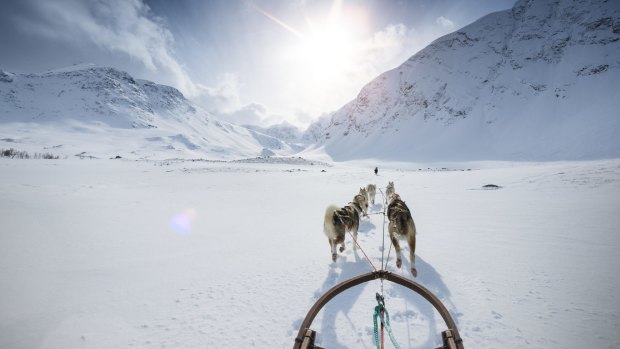
Into the wild: Alaska.Credit: Viaframe
The rotors of the little red chopper quicken to a furious beat and as we take to the air at a tilt, the woman next to me, a pastor from a small church in Virginia, looks grimly at her knees. She makes the sign of the cross.
It's a somewhat disconcerting start to a long awaited adventure, embedded in the journey of a lifetime. The journey is a seven-night luxury cruise north-by-northwest along Alaska's Inside Passage, a meandering skein of fiords, islands and inlets deeply forested where they are not snow clad; the adventure is a chance to dogsled a husky team high in glacier country white-on-white.
Minutes later, skimming above the tilted peaks in their ragged shawls of summer snow, I gaze down in wonder at the Norris Glacier sweeping majestically out of Alaska's Juneau Icefield. The glacier's surface is crusted with ridges and furrows. Here and there it glows a frosty blue.
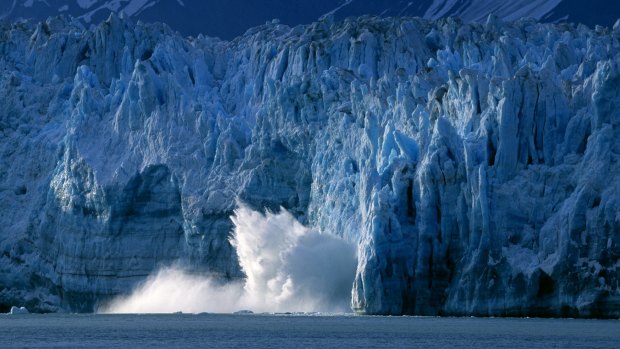
Hubbard Glacier, Alaska.Credit: Michael Melford
Our chopper touches down in a dreamy upland snowscape of fresh drifts and blurred outlines: summer home to an Alaskan huskie camp.
The dogs carry on excitedly, yelping and twisting on their restraints, and I fulfil a long-held ambition to cry "Mush!" to a team of huskies as they strain across the snow. Except that it's not mush, I learn; it's "Hup!" And off they go. One of the lead dogs – his name is Grumpy – loses a mitten on the run. I feel for him. But as our musher explains: these dogs, labouring in about 2C, are enduring balmy temperatures today. Every half a kilometre, we stop to give the panting dogs with their lolling tongues a chance to cool down.
On the way back, the chopper pilot sweeps a little closer to the glacier before climbing to the radiant white cirques and peaks and descending again through a rich green Jurassic landscape back towards the town of Juneau. "Mountain goat!" he calls as we pass an exposed blade of rock at around 2000 metres. I glimpse a shaggy horned beast nestled in its solitary upland home – and in an instant it is gone.
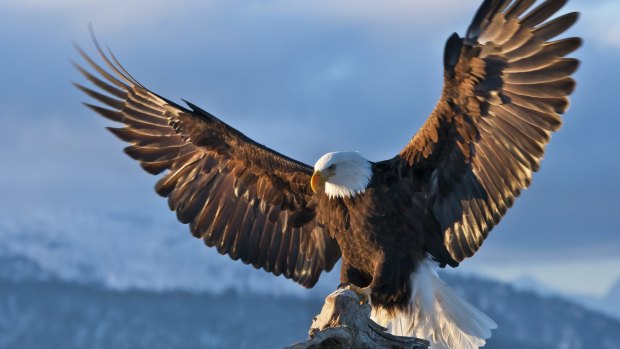
A Bald Eagle in Alaska.Credit: Keren Su
It's my fourth day into a luxury Silversea cruise that leaves Vancouver in light rain with a cocktail party for "solo travellers" to brighten the mood and bond those travelling without companions. That night I find myself chatting with an Israeli art dealer and a financial consultant from Trinidad. The gathering is a reminder of one of the great charms of high-end cruising; even if you were to sail through a tunnel for the length of the journey it might well be worth it on account of the company.
I wake the next morning to a grey sky and a tranquil, though slightly eerie, waterway. We are threading through one of the narrowest sections of the Inside Passage, a maritime route used during the Klondike gold rush of the 1890s when 100,000 prospectors – or "stampeders" as they were known – stormed to the great Northland carrying pans, picks and provisions. Our ship is flanked this morning by an avenue of low-lying hills wrapped in ribbons of mist, and as we slice through the channel I catch only the swoosh and swish of water above a vast silence.
As the day wears on the sea thickens. Pretty soon the Silver Shadow is ploughing through troughs of two metres as it crosses the open water of Queen Charlotte Sound; not a big swell by any means but heavy enough to give a meandering thread to even the most sea-savvy passengers as they pad around the ship.
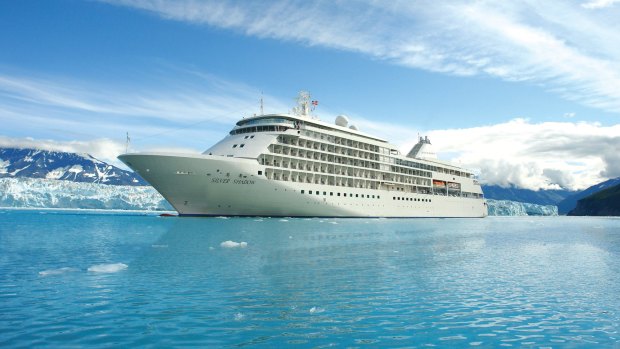
The Silver Shadow offers a seven-night luxury cruise, north-by-northwest along Alaska's Inside Passage. Credit: Getty Images
By mid afternoon the sun breaks out to splash the sea with a pewter sheen and an enormous blue vault opens above. It's a little nippy on the outer deck and while the greenish ocean water pool is empty there's a group installed in the spa bath tossing back glasses of bubbly in the soft sunshine.
I've already feasted on the freshest possible salmon served several ways, equally fresh scallops and mussels accompanied by crisp French and Italian whites. At dinner in the main restaurant I settle on Alaskan cod following an entree of white truffle risotto: so good!
Out on the deck for the late sunset an ornamental crescent moon hangs in a lapis lazuli sky, and above it winks the bright pendant of early rising Venus. The sunset lingers, and so does the entertainment; after a '60s Brit pop floorshow I hit the disco, then the piano bar, and sometime around midnight four Puerto Rican women take to the stage to belt out Guantanamera as their husbands look glowingly on.
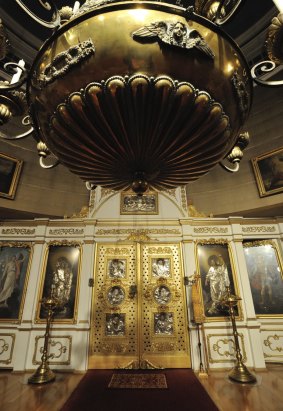
Saint Michaels Orthodox Cathedral, Sitka, Alaska.Credit: Jonathan Kingston
We arrive the next morning at our first stop: the vibrant Alaskan port of Ketchikan. I book in for a "Sea Cycle Ocean Adventure", despite fears that there might be more than a little hyperbole to the promised "adventure". I couldn't have been more wrong.
We set out across the deep black waters of Ward Cove from a dock some 15 minutes from the main town of Ketchikan on our sea cycles – in effect, paddle powered personal catamarans. A floating ghost town mouldering atop an islet of cedar logs spins slowly by. "Up until the 1950s, when this was primarily a logging and fishing town, there might have been 100 people living on these log islands," says our guide, Vicki, an Arizona girl who made her way north a decade ago. "I have a friend in town who remembers growing up here. The children would befriend the seals, toss them balls."
At the mention of the word seal an oily black puppyish face emerges from the water, as if summoned. It regards Vicki curiously, though not lingeringly, before shimmying back to the depths.
We paddle further along the shore towards a river where fresh and saltwater meet and the salmon will soon start their journey upstream. Vicki points to a bend in the river where white water rushes over a bed of pale pebbles. "Sometimes," she says, "we see bears fishing there. But the bear from last season," she continues in a lower tone, "had to be put down. It had gotten a little too friendly with people."
I'm about to ask how a bear expresses its friendship when Vicki motions to two bald eagles – serene, proud and magnificent – perched heavily on the bough of a cedar beside the river. We paddle a little closer. These monarchs of the skies are covered in handsome plumage of chocolate brown below their distinctive vanilla cowls. They, too, are waiting for the salmon. We paddle quietly to within 50 metres of the pair before one pivots from its perch, drops a little in the air due to its weight and with a few deep slow beats of its enormous wings glides off into the woods.
The hills encircling Ketchikan are clad in fir forests of red and yellow cedar, alder, hemlock and spruce; and for the next half an hour we paddle along the edge of a dense forest thrusting from a cliff face encrusted at the waterline with tiny black mussels like a glittering seam of coal. Nobody ever bothers to pick the mussels, Vicki explains, because the salmon here is so damn good. "I have become," she admits, "a salmon snob. I pretty much only eat sockeye".
Heading back into open water we spy another bald eagle as it swoops from its nest to harass a seagull barely five metres from us. We stop. "The eagles will do that," Vicki explains in a light tone. "They drive the seagulls away; show them who is boss."
But there is something a little too insistent about this assertion of avian authority. Each time the white gull takes flight the eagle bears down on it. Time and again the poor gull is driven back to the relative safety of the water, where it pauses to regather its strength before rising again. The distressed gull lets out a cry as a second eagle spirals in, followed by a party of three gulls, circling around the two eagles, niggling and distracting: it's an air war. Finally the larger of the two raptors swoops decisively, snares the besieged gull in its hand-sized yellow talons, and flies off triumphantly to a nearby island to deliver the coup de grace.
I look to Vicki. Her colour is raised. "Oh. My. God," she says. "I have never seen that. Ten years in this town. Four years doing this job. And not once! They always look like they are shooing the gulls away."
"Oh man!" booms one of the group. "That was better than Discovery Channel."
Paddling back towards base Vicki spots an Alaskan salmon leaping from the water. When the fish breaks the surface again it skims for perhaps 50 metres, leaving a glittering zip on the black laminate waters.
We sail away that afternoon beneath a gorgeous clear sky. Passing through an ice channel of glassy eddies a voice of authority, Italo-Australian captain Alessandro Zanello, crackles out on the intercom: "Whales on the starboard side". The doors of hundreds of cabins are flung open and a crowd gathers outside in the crisp air. Three whales, working their way down the channel, are greeted like rock stars with shrieks of joy.
This is the night the Silver Shadow docks at the old gold mining town of Juneau, nestled at the base of a plunging peak with a midsummer mantle of forest: the base for dogsledding in the nearby ice fields. The next night, wired by the sledding and the eagle-like swooping of the chopper through that magical snow country – as well as a few glasses of prosecco – I resolve to stay awake for the northern sunset. But here's the thing: the midsummer sun may set at this latitude, though it never really dims. When I close the curtains to my cabin at 2 in the morning, pale sunlight still gleams white gold on the western horizon.
As we travel north the drama of landscape intensifies, and at Skagway, a mining town whose first timbers were hammered in the Klondike gold rush, the snowcapped crags encircling the harbour possess an alpine majesty. It's here in the 1890s that the stampeders – 220 of them from Australia – trekked across the White Pass to the goldfields inland. Most returned through Skagway months later, pockets empty, dreams broken. I take a seat at the local historical centre to watch a documentary about the earliest years, and when I step out into the bright street again I see not an ersatz gold town but a real one given a bit of a spit and polish.
The sailing that afternoon across an open waterway ringed by jewelled snowy peaks is especially beautiful, and in the morning we arrive at Sitka, a tiny hamlet, Russian in origin, on the edge of a deep sound sheltered from the worst of the boisterous northern Pacific by Kruzov and Baranof islands. From the deck I watch small whales in the waters. Sea lions, too.
Where Skagway preserves the memory of 1890s gold fever, Sitka recalls the legacy of Russian exploration. Seeking otter and fur seal pelts beyond Siberia, Russian traders established an outpost in Sitka in the 1790s, provoking a fierce struggle with the native Tlingit people. I pay a visit to the wooden Cathedral of St Michael, its bell tower, onion dome and gilded interior all sweetly reminiscent of Russian orthodoxy with its incense and vespers, its chandeliers and its silvery icons. In the church I say a prayer to the Virgin of Sitka, who is thought to intercede in matters of eyesight, hoping to stave off another visit to the optometrist.
That afternoon, as we set off for the Hubbard glacier, we have the company of perhaps 20 whales on either side, sending their festive detonations of sea spray skyward. At around midnight the white-blue peaks above the magnificent Brady Glacier glow like phosphorescence against the fading light. I wake to a grey-green bay draped with a scattering of brush ice ranging in size from surfboard size chunks to monoliths the mass of apartment blocks. The ice – not pack ice but glacial debris – is varicoloured. Some pieces glint like crystal islets, others are disappointingly silt smudged, and still others glow a gorgeous mint blue. But they all share a common origin and it looms ahead as the Silver Shadow edges ever closer: the magnificent Hubbard Glacier.
Hubbard glacier is the largest – and in the view of many most beautiful – ice river of its kind in North America. It begins its journey 122 kilometres away in Canada, advancing slowly – glacially – down to the coast to end its life here in the evocatively named Disenchantment Bay.
As the passengers gather excitedly on the observation deck in the chill early morning air, a deep discontented rumble issues from the glacier's massive snout. In this fine weather the captain is taking us close; up close and personal. We are some 500 metres from the face of the great glacier.
Suddenly there is a crack and a boom – the Tlingit, I'm told, call it "white thunder" – and a great shard of blue-white ice slides into the sea, sending up a cloud of froth and snow dust. It is like a death of sorts, and a life too: for with these tremendous offerings of ice bearing silt from the uplands the glacier stirs the sea and feeds it. At the point where the glacier ends its journey, ours ends too. That afternoon we sail up the coast across the Gulf of Alaska, across the 60th parallel, heading toward our final destination of Seward and hundreds of heart-felt goodbyes.
TRIP NOTES
MORE INFORMATION
GETTING THERE
Air Canada offers direct daily flights from Sydney and Brisbane to Vancouver; see www.aircanada.com
CRUISING THERE
The Silver Shadow is a luxury liner with a capacity for 380 passengers and 290 crew. Early prices for the ship's Vancouver to Seward (Alaska) cruise in May 2017 begin at $3915. Dining options include a la carte Italian, La Terrazza and La Champagne, the only Relais & Chateaux wine restaurant at sea. Activities from fishing to dog-sledding are available at each port of call. See www.silversea.com
Luke Slattery was a guest of Silversea cruises.
NORTHERN EXPOSURE
ZIP IT UP
In Ketchikan, Alaska, enjoy a half-day rainforest excursion with an exhilarating zip-line ride through the forest canopy.
GLACIER FLIGHTS
In Juneau, take a float plane above the icefield to observe five of its famed glaciers before landing on a glacier lake in front of the Taku glacier.
GOLD RUSH
In Skagway, ride the White Pass and Yukon railroad and take a trip back in time to the Klondike goldrush of the 1890s.
WILDLIFE
In Sitka take a half-day catamaran cruise in pursuit of sea otters, raptors and bears.
GLASS CLASS
In Seward, your ship's destination, take the Grandview train to Anchorage to view glaciers and fiords from a glass-top carriage.
Sign up for the Traveller Deals newsletter
Get exclusive travel deals delivered straight to your inbox. Sign up now.